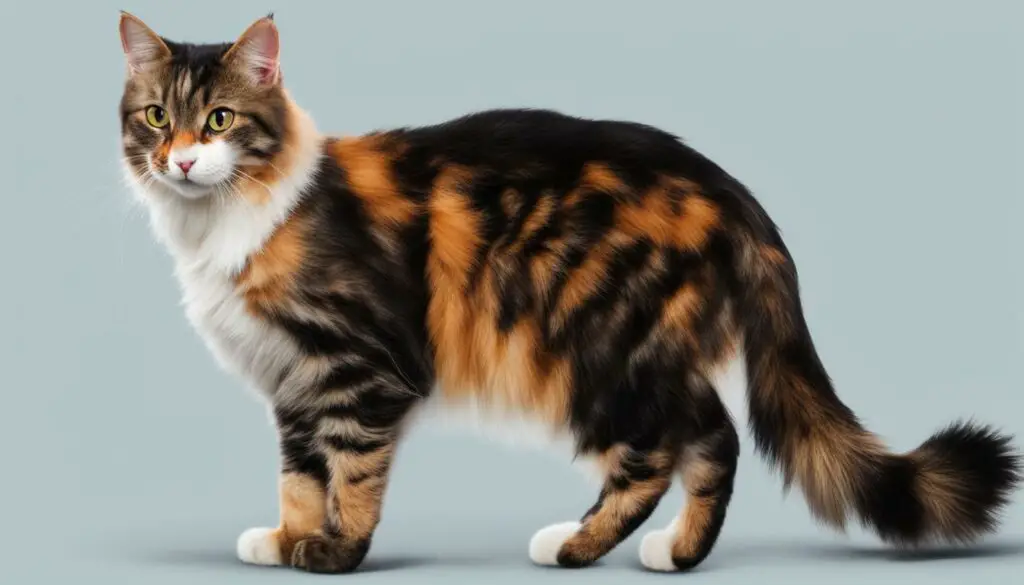Cat overgrooming base of tail, also known as excessive grooming, can be a concerning issue for cat owners. This behavior can result in hair loss, sores, and skin inflammation, causing discomfort and distress for our feline friends. However, understanding the causes behind this behavior and finding effective solutions is essential in addressing the problem and ensuring the well-being of our cats.
There are various factors that can contribute to cat overgrooming at the base of the tail. It can be the result of behavioral issues, such as stress, anxiety, and boredom, or it can be a sign of underlying medical conditions, such as allergies, skin infections, or parasites. Identifying the specific cause is crucial in determining the appropriate treatment and management approach.
In this article, I will delve into the different causes of cat overgrooming base of tail, both behavioral and medical, and provide insights on how to identify and diagnose the underlying issue. I will also discuss various treatment options, preventive measures, and additional tips for managing cat overgrooming. Remember, if you’re unsure or the overgrooming persists, it is always advisable to seek veterinary advice for proper diagnosis and personalized treatment plans.
Key Takeaways:
- Cat overgrooming base of tail can lead to hair loss, sores, and skin inflammation.
- Causes can be behavioral, such as stress and anxiety, or medical, such as allergies and parasites.
- Proper diagnosis by a veterinarian is essential in identifying the underlying cause.
- Treatment options include stress management, environmental enrichment, medication, and behavior modification.
- Preventing cat overgrooming involves reducing stress, maintaining a balanced diet, and regular veterinary care.
What is Cat Overgrooming?
Cat overgrooming refers to the excessive and repetitive licking or grooming behavior that cats exhibit. This behavior can lead to skin inflammation, development of sores, and hair loss. It may manifest as bald patches or thinning fur in the affected area, particularly at the base of the tail. Identifying and addressing the underlying causes of cat overgrooming is essential to prevent further complications and improve the cat’s overall well-being.
When a cat overgrooms, it can cause skin irritation and damage, resulting in inflammation and the formation of sores. The constant licking or grooming can also lead to hair loss in the affected area. In some cases, the base of the tail is particularly prone to overgrooming due to its accessibility for the cat’s tongue.
A visually engaging representation of how cat overgrooming can affect the base of the tail is provided in the table below:
| Severity | Description |
|---|---|
| Mild | Thinning of fur at the base of the tail |
| Moderate | Patchy hair loss with visible redness |
| Severe | Intense skin inflammation, open sores, and extensive hair loss |
It’s important to note that cat overgrooming is not a normal grooming behavior and should not be ignored. Identifying the underlying causes and providing appropriate treatment is essential in addressing this issue and ensuring the well-being of your cat.
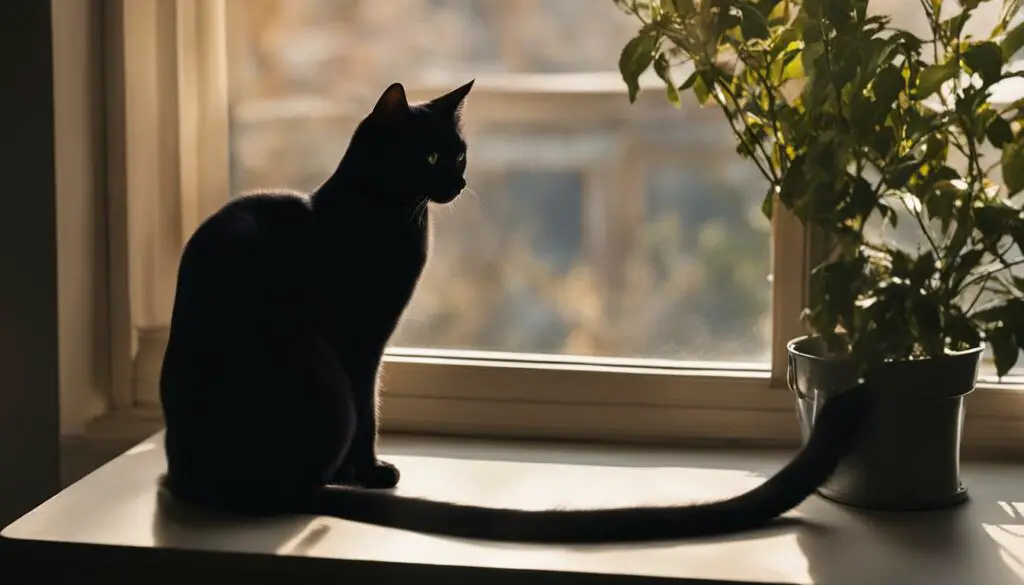
Note: The provided image visually illustrates the effects of cat overgrooming on the base of the tail.
Common Causes of Cat Overgrooming
Cat overgrooming can be caused by a variety of factors, including behavioral issues and medical conditions. Understanding the common causes of this behavior is essential in identifying the underlying problem and finding appropriate solutions. Here are some of the most common causes of cat overgrooming:
Behavioral Issues
- Stress: Cats may overgroom as a response to stress or anxiety. Changes in their environment, such as moving to a new home or the introduction of a new pet, can trigger this behavior.
- Boredom: Cats that lack mental and physical stimulation may engage in excessive grooming as a way to alleviate boredom.
- Anxiety: Cats with separation anxiety or fear-related issues may resort to overgrooming as a coping mechanism.
Medical Conditions
- Allergies: Cats can develop allergies to certain foods, flea bites, or environmental factors, leading to skin irritation and excessive grooming.
- Skin Infections: Bacterial or fungal infections can cause itching and discomfort, prompting cats to groom excessively.
- Parasites: Fleas, mites, and other parasites can infest a cat’s fur, causing intense itching and compulsive grooming.
- Underlying Health Conditions: Certain health issues, such as thyroid disorders or pain from arthritis, can contribute to overgrooming behavior.
Identifying the specific cause of your cat’s overgrooming is essential in developing an effective treatment plan. Some cases may require professional help from a veterinarian or animal behaviorist to address the underlying issues and provide appropriate interventions.
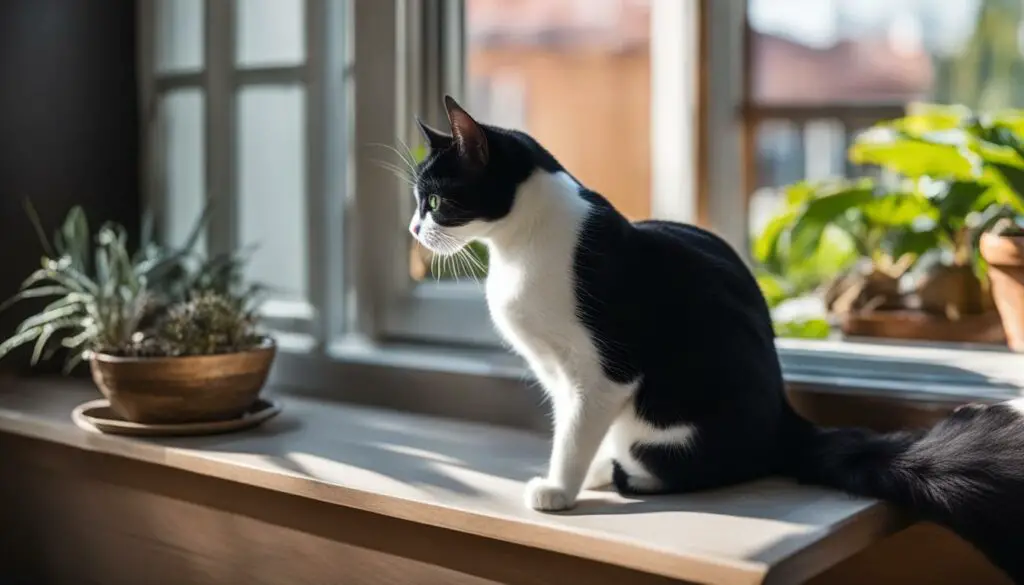
Table: Common Causes of Cat Overgrooming
| Behavioral Issues | Medical Conditions |
|---|---|
| Stress | Allergies |
| Boredom | Skin Infections |
| Anxiety | Parasites |
| Underlying Health Conditions |
It’s important to consult with a veterinarian to properly diagnose and address the cause of your cat’s overgrooming. They can provide guidance on behavior modification techniques, recommend appropriate medical treatments, and help ensure the overall well-being of your furry friend.
Behavioral Causes of Cat Overgrooming
Cat overgrooming can often be attributed to behavioral causes, which may include stress, anxiety, boredom, or changes in the cat’s environment. These factors can trigger excessive grooming behavior in cats, particularly in the base of their tail. It is important to understand and address these behavioral causes in order to help manage the overgrooming and improve the overall well-being of the cat.
Stress can be a significant factor in cat overgrooming. Cats can become stressed due to various reasons such as living in a multicat household, the introduction of a new family member or pet, or changes in their routine. This stress can manifest in excessive grooming as a coping mechanism. By identifying and alleviating sources of stress, such as providing a calm and enriched environment, engaging in interactive play, and establishing a consistent routine, the cat’s overgrooming behavior can be reduced.
Anxiety and boredom can also contribute to cat overgrooming. Cats that lack mental and physical stimulation may resort to excessive grooming as a means of relieving their restlessness. Providing environmental enrichment, such as puzzle toys, scratching posts, and interactive play sessions, can help alleviate boredom and redirect the cat’s energy towards more appropriate behaviors.
Changes in the cat’s environment, such as moving to a new home or rearranging furniture, can also trigger overgrooming. Cats are creatures of habit and may become stressed or anxious when their familiar surroundings change. Gradually introducing changes and providing a comfortable and safe space for the cat can help minimize the impact of these environmental changes on their grooming behavior.
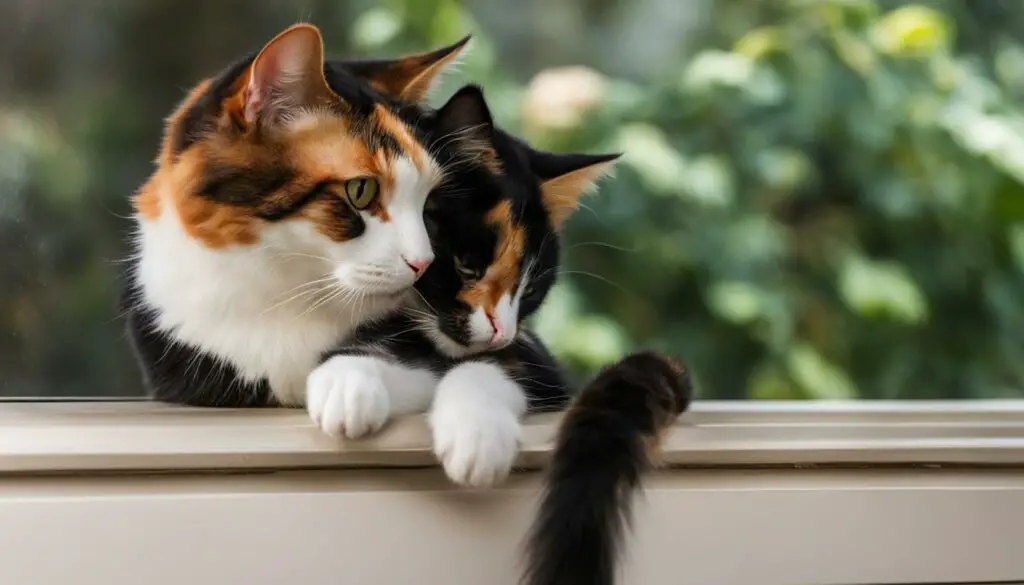
In conclusion, behavioral causes such as stress, anxiety, boredom, and changes in the environment can contribute to cat overgrooming. By addressing these underlying behavioral factors and providing appropriate stimulation and stress reduction techniques, cat owners can help their feline companions manage the excessive grooming behavior and improve their overall well-being.
Medical Causes of Cat Overgrooming
When it comes to cat overgrooming, there are several medical causes that can contribute to this behavior. Understanding these underlying health issues is crucial in effectively treating and managing cat overgrooming. Some common medical causes include:
- Allergies: Cats can develop allergies to various substances, including certain foods or environmental allergens. These allergies can cause skin irritation and itching, leading to overgrooming.
- Skin Infections: Bacterial or fungal infections on the skin can cause discomfort and itchiness, prompting cats to excessively groom the affected area.
- Parasites: Fleas and mites are common parasites that can infest a cat’s fur and skin, causing intense itching and irritation. Cats may overgroom in an attempt to relieve the discomfort caused by these pests.
- Underlying Health Conditions: Certain underlying health conditions, such as hormonal imbalances or chronic pain, can contribute to cat overgrooming. These conditions may require specific treatment and management approaches.
Proper diagnosis and treatment of these medical causes are essential in addressing cat overgrooming. A veterinarian will be able to conduct a thorough evaluation, perform necessary diagnostic tests, and recommend appropriate treatment options based on the specific underlying health issues. By addressing these medical causes, cat owners can help alleviate the overgrooming behavior and improve their cat’s overall well-being.
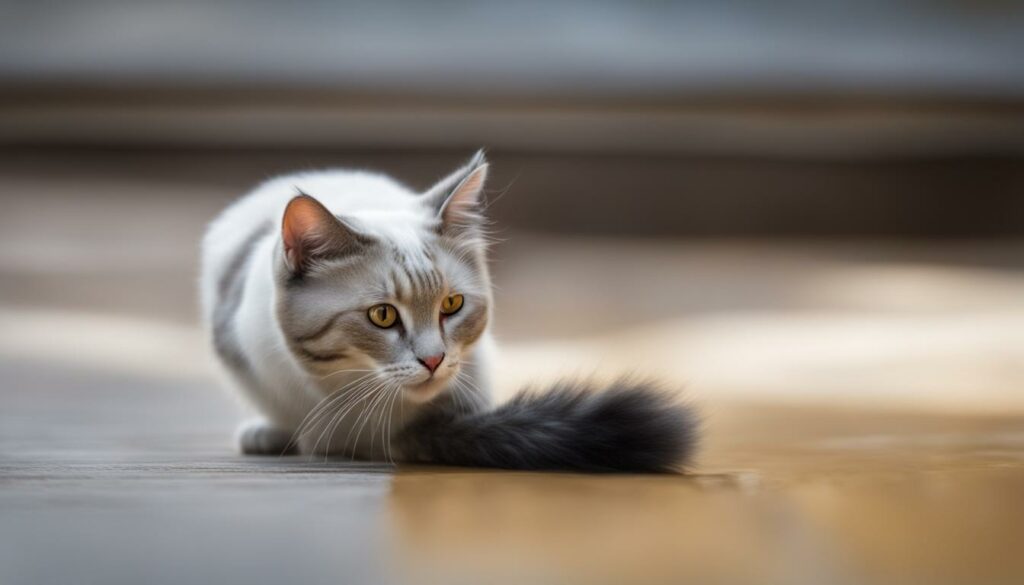
| Medical Causes | Main Symptoms | Treatment |
|---|---|---|
| Allergies | Red, inflamed skin; itching; hair loss | Identification and removal of allergen; medication (antihistamines or corticosteroids) |
| Skin Infections | Redness, swelling, sores; discharge; hair loss | Topical or oral antibiotics/antifungal medications; proper hygiene and wound care |
| Parasites | Intense itching; visible fleas or mites; hair loss | Regular flea prevention; medication to eliminate parasites; proper hygiene and cleaning of the environment |
| Underlying Health Conditions | Varies depending on the condition (e.g., excessive thirst, weight loss, lethargy) | Targeted treatment or management approaches based on the specific condition; consultation with a veterinarian |
Identifying and Diagnosing the Cause of Cat Overgrooming
When dealing with cat overgrooming, it is essential to identify and diagnose the underlying cause in order to provide appropriate treatment and management. To achieve this, a comprehensive evaluation by a veterinarian is necessary. During this process, the veterinarian will conduct a physical examination and gather a thorough medical history to gain insights into the cat’s overall health and any potential contributing factors.
The physical examination allows the veterinarian to assess the cat’s skin condition, inspect the base of the tail for signs of inflammation or sores, and check for any other abnormalities. They may also perform additional diagnostic tests to further investigate potential causes. These tests can include bloodwork to check for underlying health conditions, skin scrapings to detect parasites or infections, or allergy testing to identify potential allergies that may be triggering the overgrooming behavior.
By combining the information gathered from the physical examination, medical history, and diagnostic tests, the veterinarian can establish a diagnosis and determine the most appropriate course of action. This tailored approach ensures that the underlying cause of the cat’s overgrooming is addressed, leading to effective treatment and management.
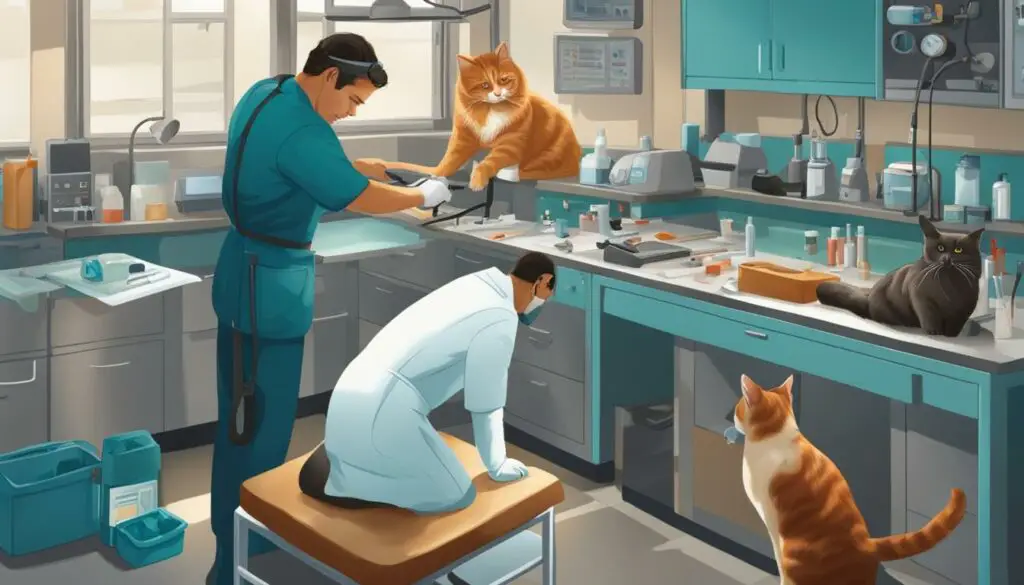
Common Diagnostic Tests for Cat Overgrooming
| Diagnostic Test | Purpose |
|---|---|
| Bloodwork | To check for underlying health conditions such as hormonal imbalances or organ dysfunction. |
| Skin Scraping | To detect the presence of parasites like fleas or mites, or identify skin infections. |
| Allergy Testing | To determine if the cat has any specific allergies that may be causing the overgrooming behavior. |
Seeking veterinary advice and conducting appropriate diagnostic tests are crucial steps in identifying and diagnosing the cause of cat overgrooming. This process allows for targeted treatment and management, leading to improved well-being for the cat.
Treating Behavioral Causes of Cat Overgrooming
When addressing the behavioral causes of cat overgrooming, there are several approaches that can be taken to help manage the problem. These strategies focus on stress management, environmental enrichment, and behavior modification to redirect the cat’s grooming behavior.
Stress management: Creating a calm and stress-free environment is essential in reducing the urge for excessive grooming. Providing a designated area for the cat to relax, away from noise and disturbances, can help alleviate stress. Additionally, using pheromone sprays or diffusers, such as Feliway, can create a calming atmosphere for the cat.
Environmental enrichment: Offering mental and physical stimulation is important in preventing boredom and reducing the likelihood of overgrooming. Providing interactive toys, scratching posts, and puzzle feeders can keep the cat engaged and mentally stimulated. Rotating toys and offering a variety of textures and sounds can also help keep the cat’s attention, diverting their focus from excessive grooming.
Behavior modification: Using positive reinforcement training techniques can help redirect the cat’s behavior and discourage overgrooming. Rewarding the cat for engaging in alternative behaviors, such as playing with toys or using a scratching post, can reinforce desired behaviors while distracting them from excessive grooming. It is important to be consistent and patient when implementing behavior modification strategies.
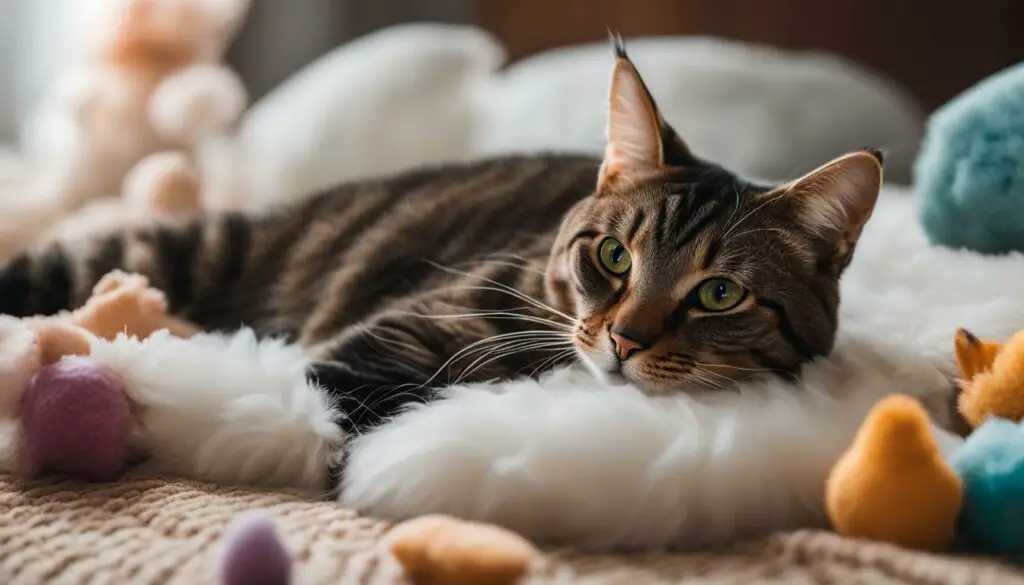
Suggested Behavior Modification Techniques:
- Interactive playtime sessions with the cat using toys to redirect their focus.
- Providing regular grooming sessions to maintain healthy coat and reduce the need for excessive grooming.
- Using puzzle feeders or treat-dispensing toys to stimulate the cat mentally and provide an alternative activity.
- Creating a routine for the cat’s daily activities to establish a sense of security and reduce stress.
By combining these strategies and tailoring them to suit the individual cat’s needs, it is possible to effectively manage and reduce cat overgrooming caused by behavioral factors. However, if the overgrooming behavior persists or worsens, it is important to consult with a veterinarian or animal behaviorist for further guidance and assistance.
Treating Medical Causes of Cat Overgrooming
When it comes to addressing medical causes of cat overgrooming, it’s important to pinpoint the specific underlying condition and implement targeted treatment strategies. The most common medical causes include allergies, skin infections, parasites, and underlying health conditions.
Allergies can cause skin irritation, triggering excessive grooming. Treatment may involve medication such as antihistamines or corticosteroids to control itching and inflammation, as well as identifying and eliminating the allergen from the cat’s environment.
Skin infections, typically caused by bacteria or fungi, can contribute to overgrooming. Topical or oral antibiotics, as well as antifungal medications, may be necessary to treat the infection and alleviate the grooming behavior.
Parasites like fleas and mites can cause itching and discomfort, leading to excessive grooming. Regular parasite control, including the use of flea prevention products, is crucial in managing overgrooming caused by these parasites.
| Medical Causes | Treatment |
|---|---|
| Allergies | Medication (antihistamines, corticosteroids) Identifying and eliminating allergens |
| Skin Infections | Topical or oral antibiotics Antifungal medications |
| Parasites | Regular parasite control (flea prevention) |
| Underlying Health Conditions | Targeted treatment or management approaches based on the specific condition |
Additionally, underlying health conditions such as hormonal imbalances or chronic pain can contribute to cat overgrooming. These conditions require targeted treatment or management approaches, which should be determined by a veterinarian based on the specific diagnosis.
It is important to consult with a veterinarian for accurate diagnosis and personalized treatment plans tailored to your cat’s individual needs. By addressing the medical causes of cat overgrooming, you can help alleviate the symptoms and improve your feline companion’s overall well-being.
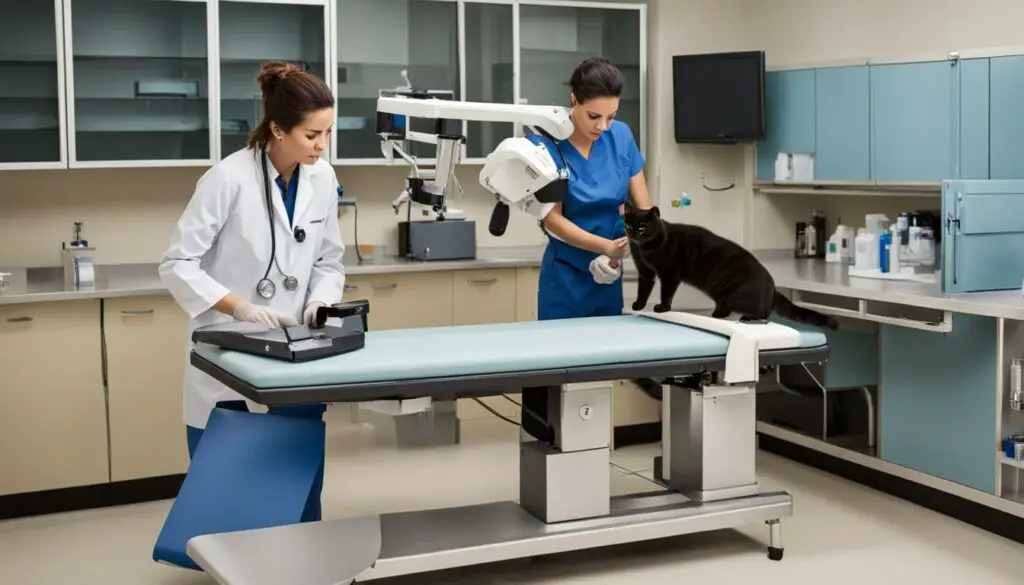
Example:
“It’s crucial to identify and treat the medical causes of cat overgrooming to alleviate the symptoms and improve your cat’s well-being,” says Dr. Smith, a veterinarian specializing in feline care. “Allergies, skin infections, parasites, and underlying health conditions can all contribute to excessive grooming behavior. By implementing targeted treatment strategies, such as medication, parasite control, and addressing underlying health conditions, you can help your cat find relief and achieve a healthier coat.”
Preventing Cat Overgrooming
Cat overgrooming can be a distressing issue, but there are steps you can take to help prevent it. By focusing on stress reduction, parasite prevention, providing a balanced diet, and regular veterinary care, you can promote your cat’s overall well-being and minimize the risk of overgrooming behavior.
Stress Reduction
Reducing stress is an important aspect of preventing cat overgrooming. Create a calm and enriching environment for your cat by providing hiding spots, vertical spaces like cat trees, and interactive toys. Establish a consistent routine and avoid sudden changes that may cause stress. Additionally, spend quality time with your cat through play sessions and gentle grooming to help them relax and feel secure.
Parasite Prevention
Regularly administering flea and tick prevention medication is essential for preventing overgrooming caused by parasites. Fleas and ticks can cause itching and discomfort, leading to excessive grooming. Consult with your veterinarian to determine the most appropriate parasite prevention method for your cat’s specific needs.
Balanced Diet and Regular Veterinary Care
A balanced and nutritious diet plays a vital role in maintaining your cat’s overall health. Ensure you are feeding them high-quality cat food that meets their nutritional requirements. Regular veterinary check-ups are crucial for early detection and management of any underlying health conditions that may contribute to overgrooming behavior. Your veterinarian can also provide guidance on dietary recommendations specific to your cat’s needs.
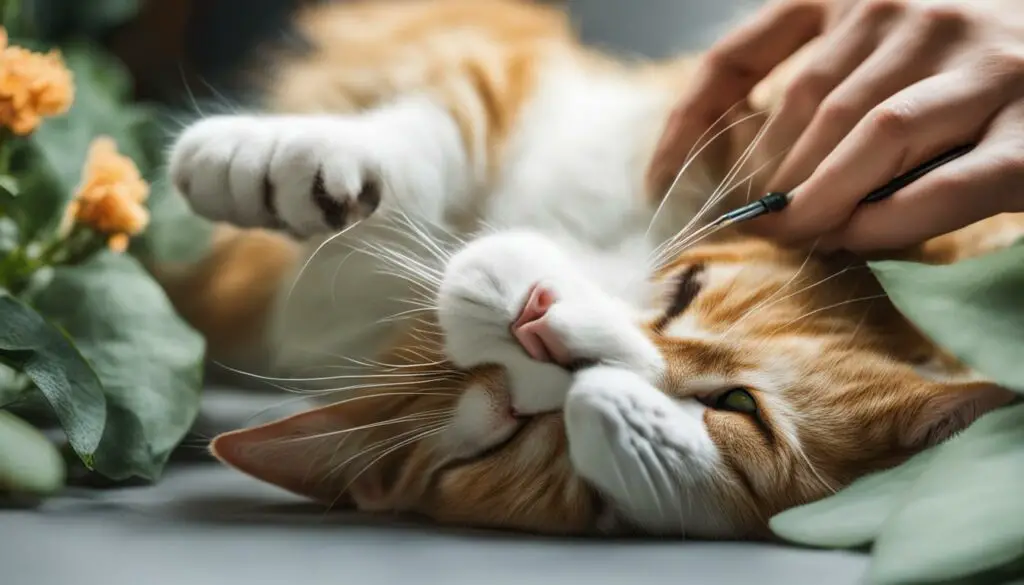
Additional Tips for Managing Cat Overgrooming
When it comes to managing cat overgrooming, there are a few additional tips and strategies that can complement the treatment approach. These tips can help redirect your cat’s grooming behavior, monitor their behavior more closely, and seek professional help if needed.
Grooming Alternatives
Providing grooming alternatives can help satisfy your cat’s grooming instincts and redirect their attention from excessive licking or grooming of the base of their tail. Interactive toys, scratching posts, or grooming brushes can all serve as effective alternatives to redirect your cat’s grooming behavior. These alternatives can offer mental and physical stimulation while helping to reduce the urge for overgrooming.
Behavior Monitoring
Regularly monitoring your cat’s grooming habits and behavior can help you identify any changes or triggers for overgrooming. Keep an eye out for excessive licking, bald patches, or any signs of skin inflammation. If you notice any changes or concerns, it’s important to consult with your veterinarian for further evaluation and guidance.
Professional Help
If your cat’s overgrooming behavior persists despite interventions, seeking professional help from a veterinarian or animal behaviorist may be necessary. These experts can provide a more in-depth evaluation, offer tailored treatment plans, and provide additional insights into managing your cat’s overgrooming behavior. Professional help can be especially beneficial for complex cases or when multiple underlying factors contribute to the overgrooming behavior.

| Additional Tips for Managing Cat Overgrooming | |
|---|---|
| Grooming Alternatives | Provide interactive toys, scratching posts, or grooming brushes as alternatives to redirect your cat’s grooming behavior. |
| Behavior Monitoring | Regularly monitor your cat’s grooming habits and behavior for any changes, signs of skin inflammation, or excessive licking. |
| Professional Help | Seek help from a veterinarian or animal behaviorist for tailored treatment plans and additional insights into managing overgrooming behavior. |
By implementing these additional tips, you can enhance your efforts in managing your cat’s overgrooming behavior and ensure their overall well-being. Remember that each cat is unique, and finding the right combination of strategies may take time and patience. Consult with your veterinarian for personalized guidance and support throughout the process.
When to Seek Veterinary Advice
If you notice that your cat is persistently overgrooming, experiencing severe skin inflammation, exhibiting behavior changes, or if you have any other health concerns, it is important to seek veterinary advice. These signs may indicate an underlying medical condition or a need for professional intervention. A veterinarian can provide expert guidance, conduct a thorough evaluation, and recommend appropriate treatment options based on your cat’s specific case.
Overgrooming that persists despite interventions: If your cat continues to overgroom despite your efforts to address the behavior through stress reduction techniques or environmental enrichment, it is recommended to consult with a veterinarian. They can help identify any underlying medical causes that may be contributing to the persistent overgrooming and recommend appropriate treatment strategies.
Severe skin inflammation: Excessive grooming can lead to skin inflammation, sores, and hair loss. If you notice that your cat’s skin is severely inflamed or if sores are present, it is important to seek veterinary advice. The veterinarian can assess the extent of the inflammation, identify any underlying causes, and provide appropriate treatment to alleviate discomfort and promote healing.
Behavior changes or other health concerns: If you observe any changes in your cat’s behavior, such as increased aggression, lethargy, or appetite changes, in addition to the overgrooming behavior, it is advisable to consult with a veterinarian. These behavior changes can be indicative of an underlying health issue that may require medical attention. Early detection and intervention are key in ensuring your cat’s well-being.
Remember, seeking veterinary advice is essential when dealing with cat overgrooming, especially when the behavior is persistent, accompanied by severe skin inflammation, behavior changes, or other health concerns. A veterinarian can provide the necessary expertise and guidance to help diagnose the underlying cause and develop a personalized treatment plan for your feline friend.
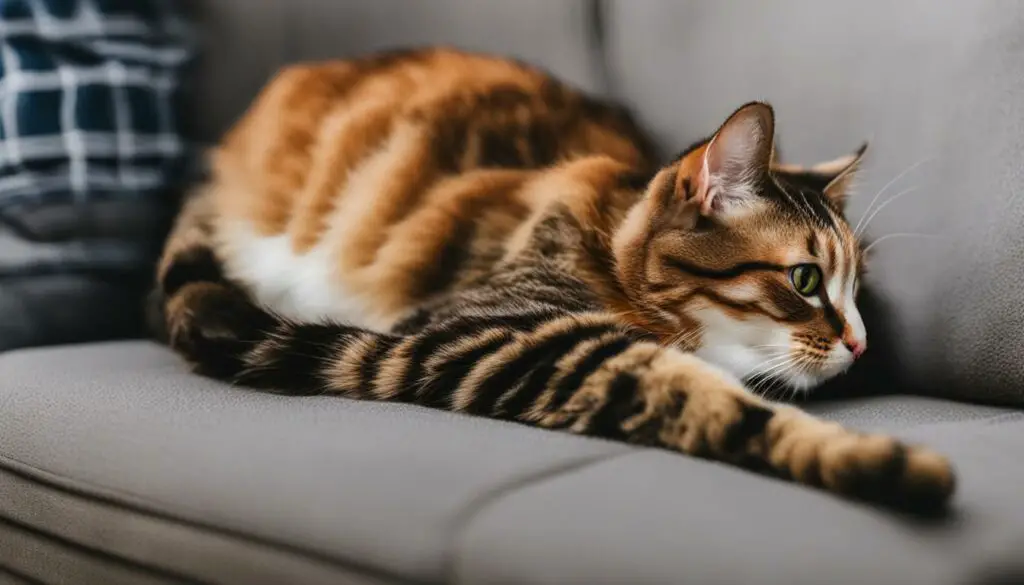
Frequently Asked Questions about Cat Overgrooming
As a cat owner, you may have several questions about cat overgrooming, its causes, solutions, and prevention. Below are some frequently asked questions to help you better understand this behavior and how to address it:
1. What are the common causes of cat overgrooming?
Cat overgrooming can be caused by both behavioral issues and medical conditions. Behavioral causes may include stress, anxiety, boredom, or changes in the cat’s environment. On the other hand, medical causes can include allergies, skin infections, parasites, or underlying health conditions.
2. How can I identify the cause of my cat’s overgrooming?
It is essential to consult with a veterinarian to identify the underlying cause of your cat’s overgrooming. The veterinarian will conduct a physical examination, gather a thorough medical history, and may perform additional diagnostic tests if necessary. This comprehensive evaluation will help determine whether the behavior is due to behavioral issues or medical conditions.
3. What are the available solutions for cat overgrooming?
The appropriate solution for cat overgrooming depends on the underlying cause. Behavioral causes may be addressed through stress management techniques, environmental enrichment, and behavior modification strategies. Medical causes may require medication, such as antihistamines for allergies or topical treatments for skin infections. It is important to work closely with your veterinarian to develop a personalized treatment plan.
| Question | Answer |
|---|---|
| 4. Can cat overgrooming be prevented? | While not all cases of cat overgrooming can be prevented, there are steps you can take to reduce the risk. This includes providing a stress-free environment, maintaining a balanced diet, regular parasite prevention, and ensuring regular veterinary care. By addressing these factors, you can help minimize the likelihood of excessive grooming behavior. |
Remember, if your cat is exhibiting overgrooming behavior, it is important to seek veterinary advice for proper diagnosis and personalized treatment. With the right approach, you can help your cat manage and alleviate the symptoms of overgrooming, ensuring their well-being and happiness.
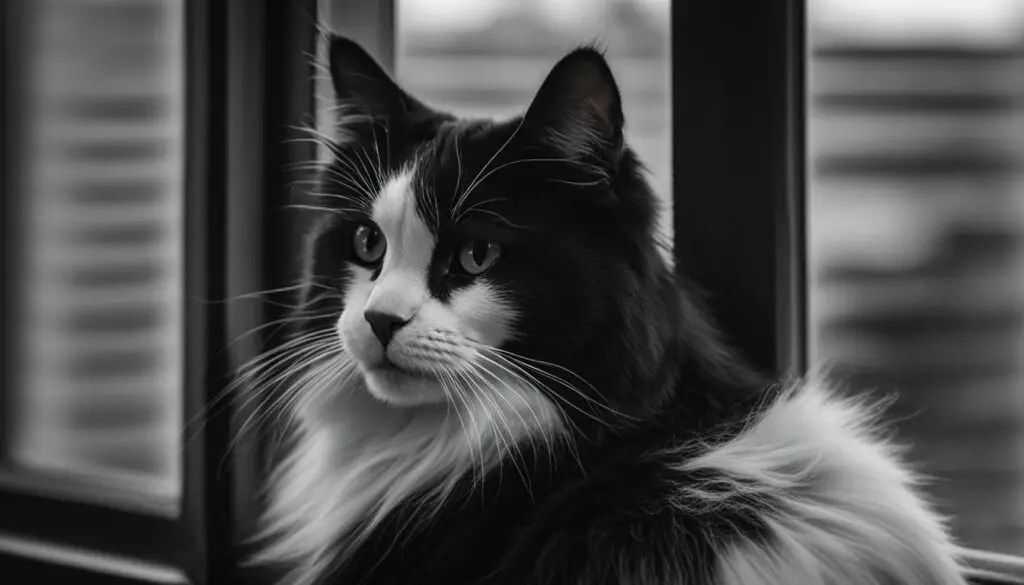
Conclusion
In conclusion, cat overgrooming at the base of the tail can be a distressing issue for both cats and their owners. Understanding the causes is crucial in finding effective solutions to address this behavior and ensure the cat’s well-being.
There are various factors that can contribute to cat overgrooming, including both behavioral issues and medical conditions. Behavioral causes may include stress, anxiety, boredom, or changes in the cat’s environment. On the other hand, medical causes can range from allergies and skin infections to parasites and underlying health conditions.
To effectively manage cat overgrooming, it is important to identify the underlying cause through a comprehensive evaluation by a veterinarian. Treatment approaches may involve addressing behavioral issues through stress management techniques, environmental enrichment, and behavior modification. Medical causes may require targeted treatment or management approaches, such as medications for allergies or skin infections, and parasite control.
By implementing appropriate treatment approaches, preventing recurrence, and prioritizing the cat’s well-being, cat owners can help manage and alleviate the symptoms of cat overgrooming. Remember to consult with a veterinarian for accurate diagnosis and personalized treatment plans tailored to your cat’s specific needs.
FAQ
What is cat overgrooming?
Cat overgrooming refers to the excessive and repetitive licking or grooming behavior that cats exhibit, which can lead to skin inflammation, sores, and hair loss.
What causes cat overgrooming?
Cat overgrooming can be caused by behavioral issues such as stress, anxiety, boredom, and changes in the cat’s environment, as well as medical conditions like allergies, skin infections, parasites, and underlying health conditions.
How can I identify the cause of my cat’s overgrooming?
Identifying and diagnosing the cause of cat overgrooming requires a comprehensive evaluation by a veterinarian, who will conduct a physical examination, gather a thorough medical history, and may perform additional diagnostic tests to determine the underlying cause.
How can I treat behavioral causes of cat overgrooming?
Treating behavioral causes of cat overgrooming involves implementing stress management techniques, providing environmental enrichment, and utilizing behavior modification strategies to reduce stress and discourage excessive grooming behavior.
How can I treat medical causes of cat overgrooming?
Treating medical causes of cat overgrooming involves addressing specific conditions identified through diagnostic tests. This may include medication for allergies, skin infections, or underlying health conditions, as well as regular parasite prevention.
How can I prevent cat overgrooming?
Preventing cat overgrooming involves strategies such as stress reduction through environmental enrichment, maintaining a balanced diet, regular parasite prevention, and ensuring regular veterinary care.
Are there any additional tips for managing cat overgrooming?
Yes, providing grooming alternatives, monitoring your cat’s grooming habits and behavior, and seeking professional help from a veterinarian or animal behaviorist are additional tips for managing cat overgrooming.
When should I seek veterinary advice for cat overgrooming?
It is important to seek veterinary advice when dealing with cat overgrooming, especially if the overgrooming behavior is persistent or accompanied by severe skin inflammation, behavior changes, or other health concerns.
What should I do if my cat is overgrooming the base of its tail?
If your cat is overgrooming the base of its tail, it is recommended to consult with a veterinarian for a proper diagnosis and personalized treatment plan based on the specific case.
Can cat overgrooming be prevented?
While cat overgrooming cannot always be prevented, implementing strategies that promote overall well-being and reduce stress can help minimize the risk of excessive grooming behavior.
How can I ensure the well-being of my cat with overgrooming?
Ensuring the well-being of your cat with overgrooming involves seeking veterinary advice, following treatment plans, providing a calm and enriched environment, and prioritizing your cat’s overall health and happiness.
Source Links
- https://www.petcubes.com/blogs/cat-losing-hair/cat-overgrooming
- https://www.purina.co.uk/articles/cats/health/daily-care/why-do-cats-overgroom
- https://petmd.com/cat/general-health/how-tell-if-your-cat-over-grooming

